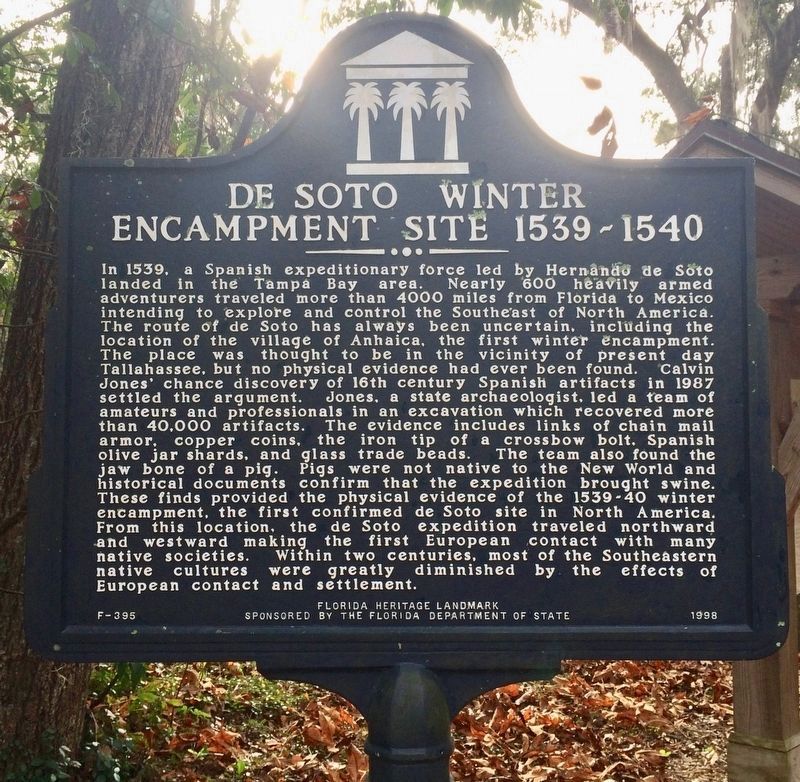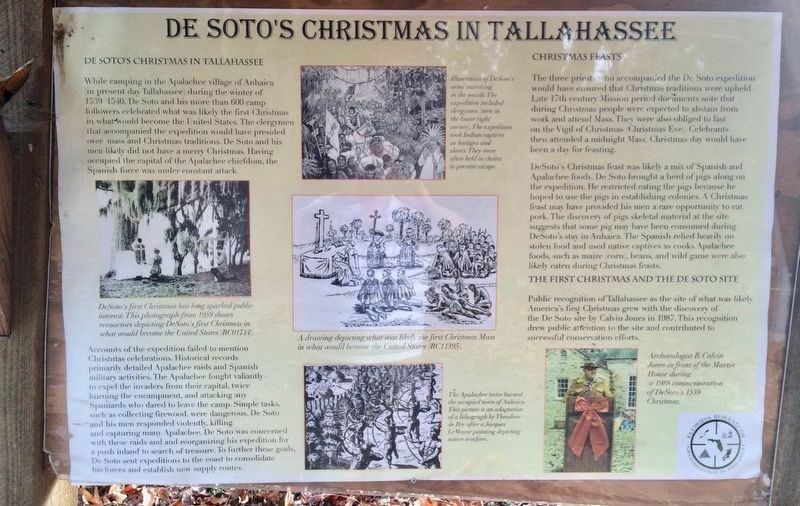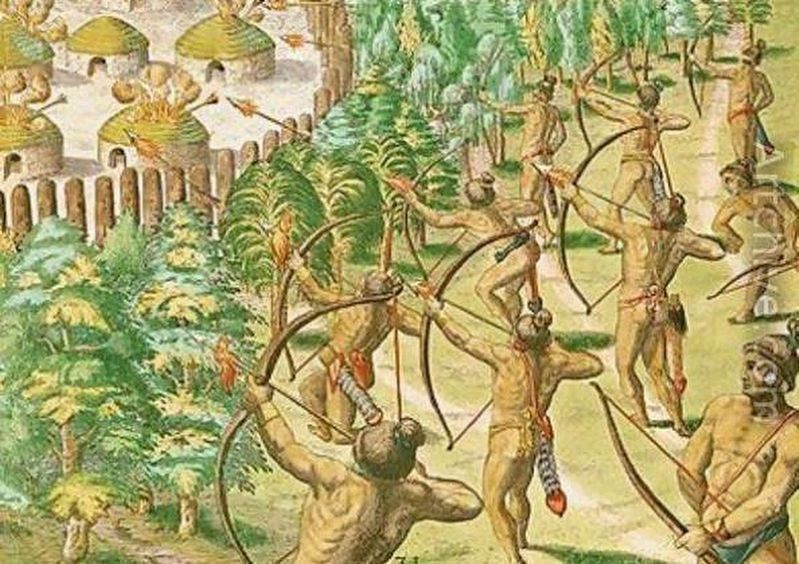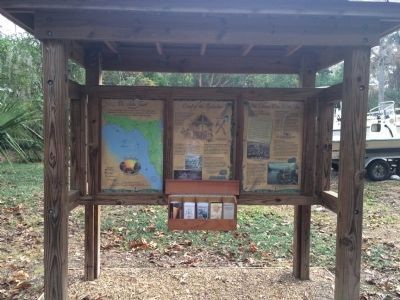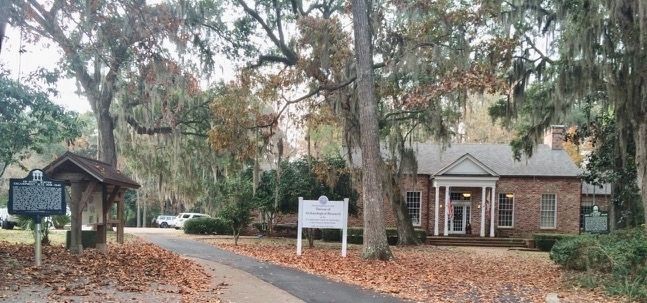Woodland Drives in Tallahassee in Leon County, Florida — The American South (South Atlantic)
De Soto Winter Encampment Site 1539~1540
Florida Heritage Landmark
Erected 1998 by the Florida Department of State. (Marker Number F-395.)
Topics. This historical marker is listed in these topic lists: Exploration • Landmarks • Native Americans • Settlements & Settlers. A significant historical year for this entry is 1539.
Location. 30° 26.169′ N, 84° 16.12′ W. Marker is in Tallahassee, Florida, in Leon County. It is in Woodland Drives. Marker is on Desoto Park Drive, 0.1 miles south of East Lafayette Street, on the left when traveling south. Touch for map. Marker is at or near this postal address: 1001 Desoto Park Drive, Tallahassee FL 32301, United States of America. Touch for directions.
Other nearby markers. At least 8 other markers are within walking distance of this marker. Governor John W. Martin House (a few steps from this marker); Land of the Apalachee (a few steps from this marker); His Dream Dies With Him (a few steps from this marker); Myers Park Historic District (approx. 0.4 miles away); Korean War Memorial (approx. 0.4 miles away); Old Fort Park (approx. half a mile away); a different marker also named Old Fort Park (approx. half a mile away); Modern Tallahassee (approx. half a mile away). Touch for a list and map of all markers in Tallahassee.
Regarding De Soto Winter Encampment Site 1539~1540.
Marker is part of the Florida de Soto Site Historic State Park, located in Tallahassee, Florida. It consists of 5 acres of land near Apalachee Parkway including the residence of former Governor John W. Martin. The site is intended to initiate research and education on nearly four centuries of recorded history beginning with Hernando de Soto's use of the site as a winter encampment in 1539.
Also see . . .
1. Hernando de Soto 1539–1540 Winter Encampment at Anhaica Apalachee. From Florida Division of Historical Resources (Submitted on December 9, 2014, by Mark Hilton of Montgomery, Alabama.)
2. DeSoto Winter Encampment - Tallahassee, Florida. From Explore Southern History (Submitted on December 9, 2014, by Mark Hilton of Montgomery, Alabama.)
Additional commentary.
1. De Soto's First Christmas in Tallahassee
The following is the text of the panel shown in photo #2
De Soto’s Christmas in Tallahassee
While camping in the Apalachee village of Anhaica (in present day Tallahassee) during the winter of 1539-1540, De Soto and his more than 600 camp followers celebrated what was likely the first Christmas in what would become the United States. The clergymen that accompanied the expedition would have presided over mass and Christmas traditions. De Soto and his men likely did not have a merry Christmas. Having occupied
the capital of the Apalachee chiefdom, the Spanish force was under constant attack.
Account of the expedition failed to mention Christmas celebrations. Historical records primarily detailed Apalachee raids and Spanish military activities. The Apalachee fought valiantly to expel the invaders from their capital, twice burning the encampment, and attacking any Spaniards who dared to leave the camp. Simple tasks, such as collecting firewood, were dangerous. De Soto and his men responded violently, killing and capturing many Apalachee. De Soto was concerned with these raids and reorganizing his expedition for a push inland to search for treasure. To further these goals, De Soto sent expeditions to the coast to consolidate his forces and establish new supply routes.
Christmas Feasts
The three priests who accompanied the De Soto expedition would have ensured that Christmas traditions were upheld. Late 17th century Mission period documents note that during Christmas people were expected to abstain from work and attend Mass. They were also obliged to fast on the Vigil of Christmas (Christmas Eve). Celebrants then attended a midnight Mass. Christmas day would have been a day for feasting.
DeSotos’s Christmas feast was likely a mix of Spanish and Apalachee foods. De Soto brought a herd of pigs along on the expedition. He restricted eating the pigs because he hoped to
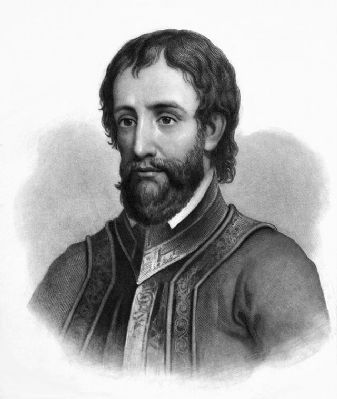
Public domain
4. Hernando de Soto
Lived from October 21, 1496 to May 21, 1542 and was a Spanish explorer and conquistador who led the first European expedition deep into the territory of the modern-day United States (Florida, Georgia, Alabama and most likely Arkansas), and the first documented European to have crossed the Mississippi River.
The First Christmas and the De Soto Site
Public recognition of Tallahassee as the site of what was likely America’s first Christmas grew with the discovery of the De Soto site by Calvin Jones in 1987. This recognition drew public attention to the site and contributed to successful conservation efforts.
Captions:
DeSoto’s first Christmas has long sparked public interest. This photograph from 1959 shows reenactors depicting DeSoto’s first Christmas in what would become the United States (RC01714).
Illustration of DeSoto’s army marching in the woods. The expedition included clergymen (seen in the lower right corner). The expedition took Indian captives as hostiges [sic] and slaves. They were often held in chains to prevent escape.
A drawing depicting what was likely the first Christmas Mass in what would become the United States (RC11395).
The Apalachee twice burned the occupied town of Anhaica. This picture is an adaptation of a lithograph by Theodore de Bry after a Jacques LeMoyne painting depicting native warfare.
Archaeologist B. Calvin Jones in front of the Martin House during a 1988 commemoration of DeSoto’s 1539 Christmas. Note To Editor only visible by Contributor and editor
— Submitted September 2, 2017, by J. Makali Bruton of Accra, Ghana.
Credits. This page was last revised on February 12, 2023. It was originally submitted on December 9, 2014, by Mark Hilton of Montgomery, Alabama. This page has been viewed 970 times since then and 75 times this year. Photos: 1, 2. submitted on December 20, 2017, by Mark Hilton of Montgomery, Alabama. 3. submitted on September 2, 2017, by J. Makali Bruton of Accra, Ghana. 4, 5. submitted on December 9, 2014, by Mark Hilton of Montgomery, Alabama. 6. submitted on December 20, 2017, by Mark Hilton of Montgomery, Alabama.
